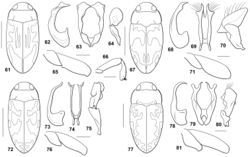Bidessodes knischi
| Notice: | This page is derived from the original publication listed below, whose author(s) should always be credited. Further contributors may edit and improve the content of this page and, consequently, need to be credited as well (see page history). Any assessment of factual correctness requires a careful review of the original article as well as of subsequent contributions.
If you are uncertain whether your planned contribution is correct or not, we suggest that you use the associated discussion page instead of editing the page directly. This page should be cited as follows (rationale):
Citation formats to copy and paste
BibTeX: @article{Miller2017ZooKeys, RIS/ Endnote: TY - JOUR Wikipedia/ Citizendium: <ref name="Miller2017ZooKeys">{{Citation See also the citation download page at the journal. |
Ordo: ORDO
Familia: FAMILIA
Genus: Bidessodes
Name
Bidessodes knischi (Zimmermann, 1921) – Wikispecies link – Pensoft Profile
- Bidessus (Bidessodes) knischi Zimmermann, 1921: 198; Blackwelder, 1944: 76.
- Bidessodes knischi, Young, 1969: 2; 1986: 209.
- Hughbosdinius leechi Spangler, 1981: 67; synonymy by Young 1986[1]: 206.
- Bidessodes (Hughbosdinius) knischi, Young, 1986: 209; Biström, 1988: 7; Nilsson, 2016: 98.
Diagnosis
This species differs from all other species in having the base of the prosternal process distinctly carinate to tectiform in both sexes. In males the ridge anteriorly is flattened and distinctly setose with those setae anteriorly distinctly forked. This species and Bidessodes obscuripennis each have the prosternal process basally carinate, at least in males, but they are otherwise rather different. In Bidessodes obscuripennis, only males are carinate. The prosternal process is flat and broad, the lateral margins are slightly convergent to the broadly rounded apex. Males of Bidessodes knischi have the metaventrite with a prominent transverse groove. The male mesotibia is unmodified. The male metafemur is very broad and rounded (Fig. 71). The male abdominal ventrite VI is distinctly impressed apically. The male genitalia are distinctive. The median lobe in ventral aspect is apically bifid with each branch obliquely bifurcated (Fig. 69). In lateral aspect the median lobe is broadly curved and apically sharply pointed with a distinct expansion along the ventral margin corresponding with the lateral branch of each bifurcation (Fig. 68). The lateral lobe is extremely broad with the apical segment very large and broadly triangular (Fig. 70). Specimens are large and robust with maculate elytra (Fig. 67).
Distribution
The types were collected from Mato Grosso, Brazil with other specimens collected from lowland areas of South America from Venezuela and Guyana south to Bolivia (Fig. 104).
Taxon Treatment
- Miller, K; 2017: A review of the Neotropical genus Bidessodes Régimbart, 1895 including description of four new species (Coleoptera, Adephaga, Dytiscidae, Hydroporinae, Bidessini) ZooKeys, (658): 9-38. doi
Images
|
Other References
- ↑ Young F (1986) Review of the predaceous water beetles of the genus Bidessodes Régimbart (Coleoptera: Dytiscidae). Entomologica Basiliensia 11: 203–220.

